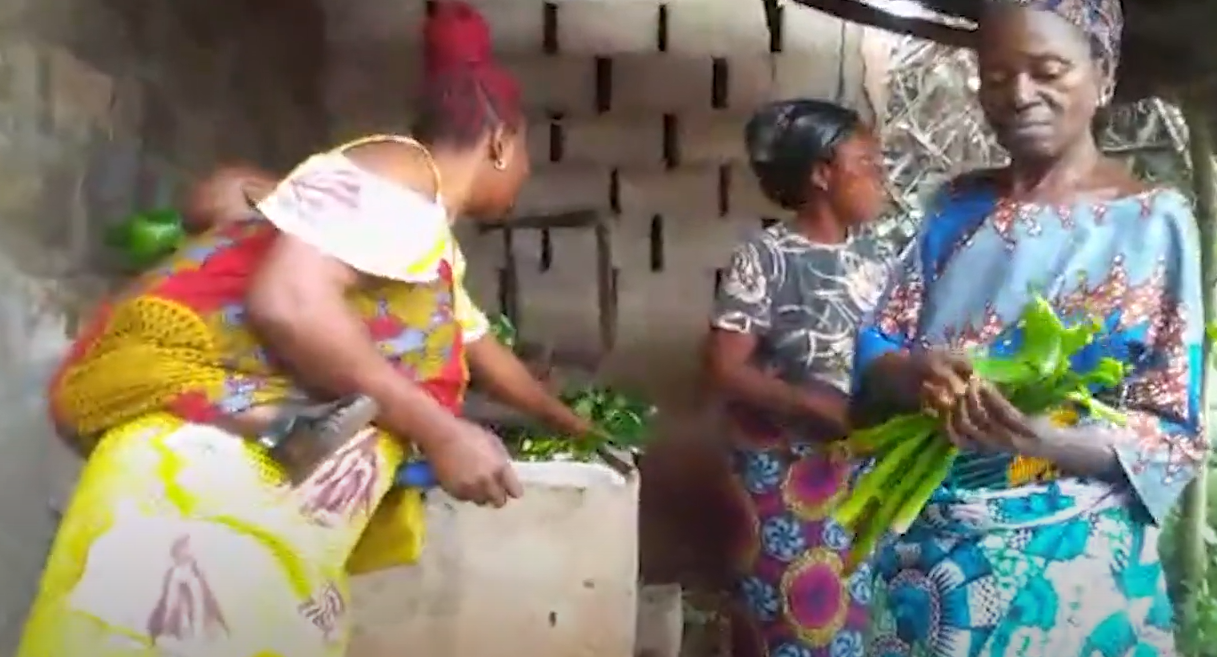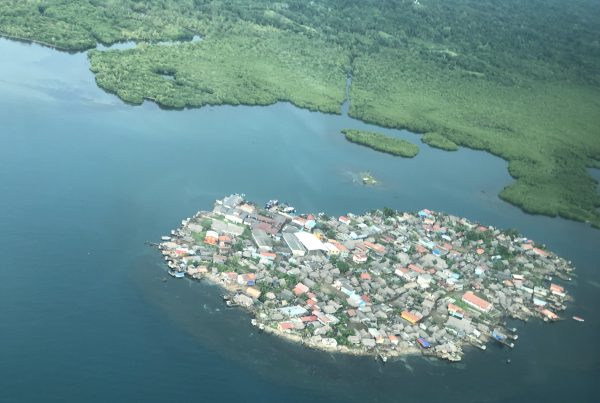Native to South America, the water hyacinth (eichhornia crassipes) has become an invasive species throughout West Africa, clogging lakes and rivers and destroying local ecosystems. In Benin, it makes canoeing extremely difficult, negatively affecting the livelihoods of local communities. However, community organisations are resisting the spread of the plant, using it to create products that they can sell.
We talk to Patrice Sagbo, a member of Actions pour le Développement Durable au Bénin, and a founding member of JINUKUN, a civil society network working on sustainable biodiversity management and the defence of the rights of local communities over genetic resources and agricultural land, who explains how this plant has affected communities. We also talk to Eugénie Bokovou, president of the Fifadji-Tognon Association, which brings together women to use this invasive species to create woven handicrafts and transform the plant into a rich compost.
Patrice –
It is not clear when water hyacinth started to become a problem. I started hearing about water hyacinth in Benin more than 30 years ago. All the continental freshwater bodies in Benin – the lakes and rivers – were attacked by the water hyacinth a very long time ago.
Clearing water hyacinth from the lake. Credit: © Sébastien Roux/Reporterre
Author
- Patrice Sagbo, member of Actions pour le Développement Durable and founding member of civil society network, JINUKUN
- Eugénie Bokovou, President of the Fifadji Tognon Association
Ecosystems
- Marine and Coastal
Topics
- Invasive alien species
Type
- Long-form
Date
- This case study forms part of LBO-2, originally released in 2020. Interviews and updates took place in 2022.
Why is the water hyacinth such a big problem?
Patrice –
The communities most affected are those who live in stilt houses on the lakes, and the people who depend on fishing for their livelihoods. This is because they have to travel by dugout canoe, to go to the market, to school, to fish, to go anywhere.
Eugenie –
The hyacinth has been invading the water for a long time. It came at the time of the flood and invaded the whole lagoon, and from that moment on, traffic is difficult and fishing is difficult. It bothers us a lot.
Patrice –
There are seasons when the lakes and rivers are completely overgrown with water hyacinth, and in order to get around we have to remove it as we go. A trip that would normally take an hour or 30 minutes can take more than five hours. You can do this for small canoes, but for large motorised canoes it is impossible to travel.
Fishermen are doubly affected, as not only does the water hyacinth makes navigation difficult, it also makes it harder to catch fish. The plant consumes so much oxygen that fish are forced to move further and further away from the affected areas in order to survive.
It even affects students, because some of them have to go to school by dugout canoe. And with the water hyacinth, they are either late or they don’t go at all. Young people have to travel to fetch drinking water, but everything becomes more difficult because of the water hyacinth.

The water hyacinth forms a carpet on the surface of the water in wetland ecosystems which impedes naviagation by canoe. Credit Patrice Sagbo

Travelling by canoe—an important way for local communities to get around—is impeded by the rapid growth of water hyacinth. Credit: Beata Tabak.
Patrice –
More and more people are hearing and seeing in the field that the water hyacinth grows more and is even more populated in highly polluted wetlands. And indeed, if one understands that the wetlands in Benin are highly polluted, and that in these highly polluted aquatic environments the water hyacinth is most often and persistently found, one tends to affirm that the water hyacinth is an indicator of pollution for the environment in which it grows, while at the same time ensuring the purification of that environment.
Before, the hyacinth was called Tôgblé in the local Fon language, which means “something that spoils the city”. No solution was found. We removed it, it came back, we removed it, and it came back again.
Eugenie –
We called it Tôgblé because it destroyed everything in its path. The water hyacinth comes with reptiles and scorpions, it brings other threats. For us, it is very dangerous. So we have to fight against this plant.
Patrice –
The government tried a science-based solution. It brought in insects to control the hyacinth, trapped them and released them on the plants to destroy them, but it did not work. The local communities had to campaign to remove the water hyacinth by hand, without government help. This was the only way they could continue their daily activities.
So people started to think about it. What if we did it differently? What if we used the hyacinth for composting? What if we used it to make items to sell? It was at this point that the women became heavily involved in turning the plant into compost, and weaving bags and other products.

Multiple products made from the water hyacinth. Credit: Patrice Sagbo
Eugenie –
By weaving it, we have seen that we are bringing value to ourselves and others. This is what has brought us to this point.
How do communities use hyacinth in a positive way?
Patrice –
The water hyacinth is harvested and the longer leaves are washed and dried before being woven into bags, mats, hats and other items that are then sold. The rest of the plant is mixed with manure and sand and left to make a rich compost, which is then used for agriculture or sold.
Eugenie –
We now get a commission for the different items. We make a lot of bottles, baskets, mats, coasters, candy dishes, hats. Everything that is ordered from us, we make with water hyacinth.
So the hyacinth is no longer Tôgblé, it has become Tognon (something that improves the country) because of its wealth.
Before, more of us worked with water hyacinth. But when you work with hyacinth, your fingers, arms, back, and spine hurt. Some couldn’t continue and and stopped. But the others work with us, and we prune, weave and wash the hyacinth together.

Weaving a hat with the dried and dyed water hyacinth. Credit: Patrice Sagbo
Eugenie –
Everyone sells what they have made, so we earn more according to the number of items we make. We put a small percentage of our income into a fund, and sometimes we use it to do something together, go somewhere, or have a party.
With the money you earn from your job, you can buy food, buy clothes for your children, or send them to school. It is your money.
We work with our children, to pass on the skills. They help us pick the water hyacinth, and the young children do the finishing touches.
We don’t just make crafts with water hyacinth. We make organic compost in collaboration with Jinukun, who does the marketing for us. This organic compost should replace the chemical fertilisers that make us sick. So we are also doing this for health. Human health is very important.
Is water hyacinth still a problem?
Patrice –
Unfortunately, the problem has not been solved. The water hyacinth is still there, because the demand for items made from the plant is very low.
The use of compost is not widespread in Benin. People continue to use chemical fertilisers because the country’s agricultural policy promotes them. People are led to believe that this is what should be used, when in reality it is the opposite.
Even the handicrafts that the women make are not popular in the local community. There is talk of pollution from non-biodegradable plastic bags. These woven bags are a solution, it’s a great alternative to plastic bags. But they are not promoted. The women need help with social marketing, with developing their market.
Eugénie and members of the Fifadji-Tognon Association weaving and singing about the water hyacinth (tognon).
Short community-made video showing the initial stages of picking, preparing and washing the water hyacinth.
Eugenie –
What we need to do now is to get out of our corner and visit centres to show our items and get support. We need to go on TV, radio shows, exhibit our items at fairs. But before you do that, you have to know what’s going on, and where. Someone has to invite you or help you to go.
During the festivals, the white people come to us and buy a lot of our products. Then we can use the money to celebrate with our children. A lot of the money we earn is thanks to those who come to Benin from abroad. People here don’t know the importance of it, so they don’t buy our products.
Patrice –
If you came to Benin and saw the shipments of bags that come from China for school children, you would realise how much currency is leaving our country when we already have local solutions. It is not up to women to promote, we need to change the political will to promote local consumption.

An unfinished sandal woven with water hyacinth. Credit: Patrice Sagbo
Patrice –
I talk about environmental issues like this on national television, but it hasn’t reached the ears of policy makers yet. Unfortunately, politicians are still outward-looking.
What will the future hold?
Patrice –
If a community collectively decided “I don’t want this in my village anymore,” we could strengthen the local economy by using only organic compost and woven bags from water hyacinth. I assure you that this is possible. The solutions are in front of us, but we need education that will transform our mentality.
You can have something good next to you without knowing that it is good. So you have to educate people, fully inform them about the benefits that water hyacinth can bring.
It used to be bad, but now it’s good. Why is it good? Because if you use it for agriculture, the plants grown are safe for your health and for the environment. Then you use it for the students. By buying cheaper school bags made from water hyacinth, more money will be left in people’s pockets, and they will be happy! In Nigeria, they even use water hyacinth to make biofuel.
I am sure that water hyacinth can disappear from our water bodies if we have a well thought-out policy, where it is no longer a problem, but a solution. And we can use this solution to solve problems at the local level. Education, awareness raising, capacity building. That’s what we need.
Eugenie –
We are eliminating pollution from our waters, we are making biodegradable bags to eliminate plastic bags that harm the environment. We can’t even afford to go by boat to get the hyacinths. We need help.
If I can make an appeal, I say to our government to think of us. We are in Ouidah. Come and see us in Seme-Kpodji.

Water hyacinth covering a body of water near a town in Benin. Credit: Patrice Sagbo
Water hyacinth, invasive species and the global biodiversity crisis.
Invasive species like the water hyacinth are a large part of the problem in biodiversity loss globally, from silk moth caterpillars in the Arctic to pond apple invasions in Australia and lion fish in Panama. These issues are only set to get worse as climate change continues. The example of the water hyacinth in Benin shows the power of people finding ways to work with these species in a way that doesn’t cause wider environmental harm, but still addresses the problems that they cause.
Solutions based on local and indigenous knowledge are an innovative and sustainable way forward for the planet to manage these invasive species and safeguard biodiversity.





